
The Business of Fashion
Agenda-setting intelligence, analysis and advice for the global fashion community.

Agenda-setting intelligence, analysis and advice for the global fashion community.
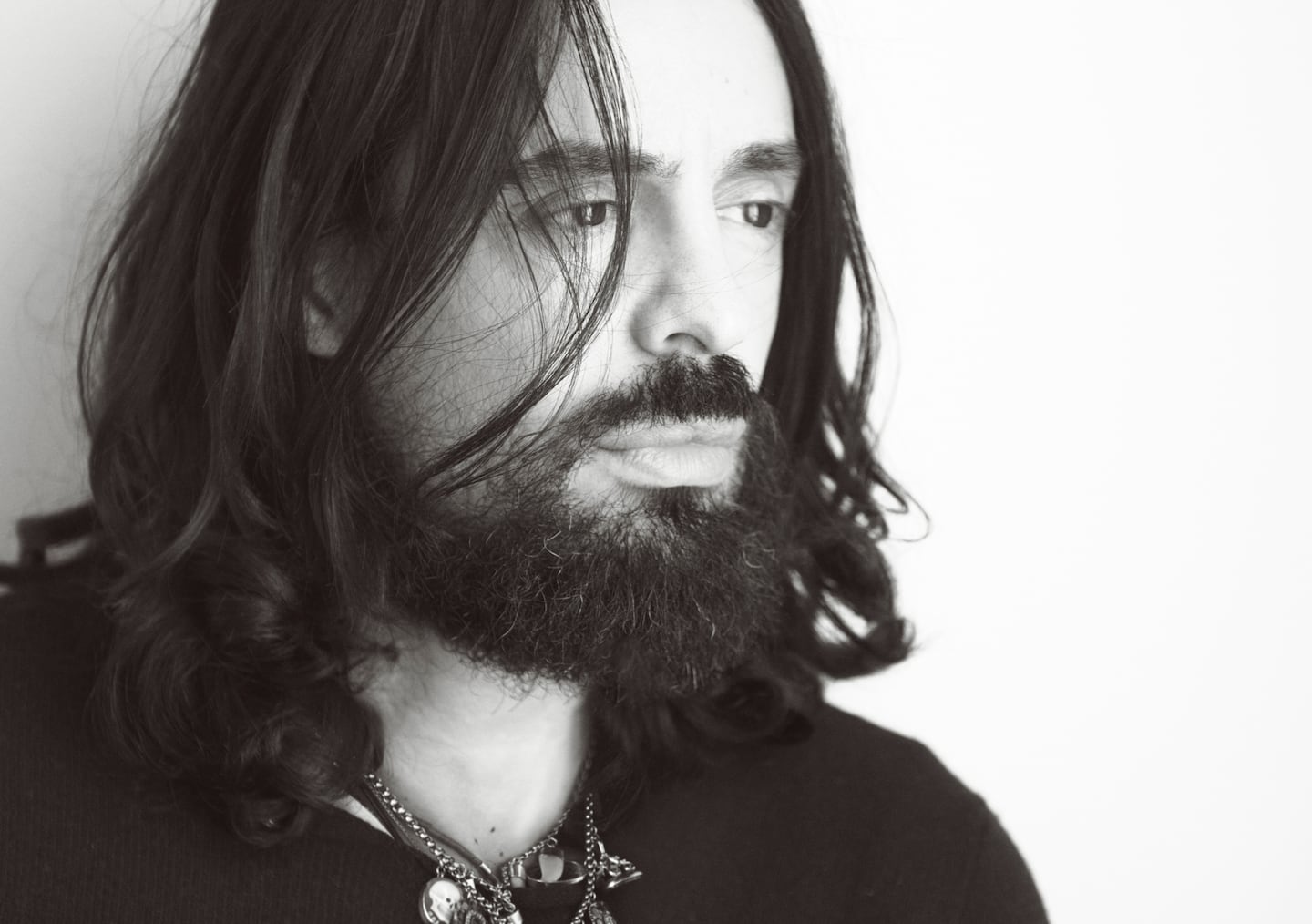
PARIS, France — It's been quite a stretch for Gucci as it has morphed under the tender ministrations of its extraordinary creative director Alessandro Michele. Maybe the most Italian fashion brand of them all, it has recently cast its questing eye towards France. First, with a pre-fall campaign that was solidly embedded with the soixante-huitardes, the youthful student insurrectionists who tore up Paris May 1968. Next, with a resort show staged in an ancient Roman necropolis in picturesque Arles in the South of France. And, now, with the presentation of its new collection for Spring/Summer 2019 at Le Palace, the Parisian nightspot that was famously Studio 54's rival as an arch-hedonist's disco heaven.
There is a big picture here. Hell, a huge picture. You think about Catherine de Medici arriving from Italy in the 16th century with her cooks and seamstresses, bequeathing France haute cuisine and haute couture. But they're not places you can go with Alessandro Michele. He is congenitally cagey when he talks about himself. "I don't want to give you the end," he says, after our lengthy conversational ramble down the twisty pathways of his life. "It belongs to you." Fine, till he adds the coda: "The end is a mystery."
But so is the beginning. The mystery is Rome, where Michele’s father would take him on long walks through parks and museums, pausing for hours in front of classical statuary, telling him about Zeus and Aphrodite, pagan gods. The mystery is his education in a convent school, with the nuns, “so weird and beautiful in these big black suits, like they were from another planet,” filling his head with stories about the coiling, sinuous evil of the Snake. The mystery is Signora Pistolesi, grandmother of the director of the Accademia di Costume e di Moda, where Michele got his fashion training: “A friend of Grace Kelly’s, a friend of Piero Tosi’s, so chic with crazy hair, beautiful jewels and presence, like when you’re in front of a masterpiece.”
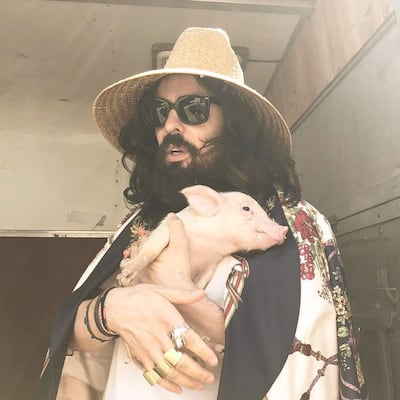
Alessandro Michele | Source: Instagram/Alessandro Michele
ADVERTISEMENT
Each mystery helps clarify how the child became father to the man who now embodies the fashion phenomenon that is Gucci, so maybe they’re not so mysterious after all. But it feels right to preserve the puzzle because Michele himself is such a scholar of the arcane. He gets a lot of his inspirations from esoteric old books. There are so many in the apartment he shares with his partner of 11 years, university professor Giovanni Attili, that he says it’s like ten people live there. And Michele’s office, a grand, vaulting space in the Renaissance palace that is Gucci’s Roman headquarters, is piled high with books. He waxes lyrical about a current fascination, sparked by a collection of 19th century tomes he found in his favourite old bookshop in Rome, which dealt with the subject of animal magnetism and the experiments that were conducted to seek the souls of wild beasts. The search for a spiritual power, something extra-dimensional that you can feel but not see, could almost be Michele’s own quest at Gucci. “Otherwise we spend all our lives trying to find the right length of skirt,” he says dismissively.
What catches my eye amidst the esoterica is an antique copy of "Alice in Wonderland," a gift from Gucci chief executive Marco Bizzarri. When he gave Alessandro the book, he had no idea that Michele collects "Alice," 35 different editions at last count. But his instinctive choice reflects the symbiotic connection between executive and designer that has transformed Gucci, and, by extension, fashion itself.
This work is like a psychological disease. I always go deep inside things I hate, things I love... it's not just a beautiful colour.
It's already the stuff of legend: Bizzarri's leftfield choice of dark horse Michele to helm slumbering giant Gucci when previous creative director Frida Giannini was let go at the end of 2014. "You see that every time in fashion they have an empty chair, they take the big star," Michele says. That's what he assumed at the time. Hedi Slimane or Riccardo Tisci were rumoured to be taking on the role. So, after years as Giannini's second-in-command, Michele was planning his exit strategy, talking to a headhunter, maybe leaving fashion altogether. "I was thinking I didn't want to work anymore in fashion," he remembers. "There were other things I wanted to do, not really fashion. I was open to designing costumes for movies." But Bizzarri didn't take the big star. He talked to Michele instead. "The karma was so strange because there was a point where nothing happened, and then there was the point where everything happened."
If you created a word cloud of Michele’s conversation, KARMA would appear big, front and centre. “Karma is connection,” he enthuses. “It’s like a spell, it attracts people. I love every single person who is in touch with me, and we can share the same things.” LOVE, LIFE and ENERGY are other words he uses a lot, WEIRD and CREEPY only a little less so. MOVIE, LANGUAGE and DIMENSION are also there. The words are like a framework, “a fresco of life,” Michele says, “a new language made from different ages and places and lives. The idea that fashion can change something about you is very powerful. So, when you’re on top of a very big company, you have a voice. You need to describe more about life, less about skirts. I’m a good tailor, I know that, but it’s like when you’re singing, it’s not enough to talk about the notes in your voice. It’s more about what the song is saying when you’re singing. In the past, brands didn’t have this power… When I started, I wanted to push people to think in a different way, different ideas, not just different clothes.”
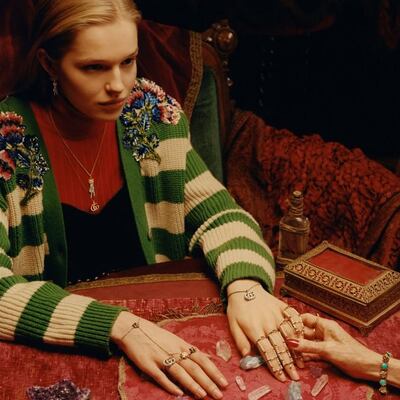
Gucci jewellery and watches campaign | Source: Instagram/Gucci
“It was a weird way to work in the beginning, so I’m surprised it’s really working on the customers. After the first show I did, I thought I would be fired by Marco. But I didn’t want to follow the rules of fashion. Every time we had a meeting together, I knew the rules, I was a young guy who’d grown up in fashion, so I understood everything about marketing and products, but I wanted to try and do things from my point of view, something that was really creepy and weird. The most beautiful thing was that I didn’t think at that time it would be possible to build what we have now.”
“Do you think Marco knew?” I wonder.
“Yes, I do,” Michele replies, “but he was the only one. And he didn’t know everything, but he felt something. Because if he didn’t, he was totally crazy.” Michele laughs heartily at the thought. “He was in a worse position than me.”
ADVERTISEMENT
There was a kind of nothing-to-lose defiance in the whole scenario. It translated on Michele's catwalk into an assault on fashion propriety and proportion that came across as an eccentric update on the original spirit of punk. The whiff of confrontation lingers to this day, not only in the exotic farrago of clothing and accessories for men and women that Michele unleashes on the world each season, but in the coterie of singular originals he has drawn to him. Jared Leto, Tori Amos, Florence Welch, Ari Marcopoulos and Nick and Susie Cave are just about the most idiosyncratic tribe in fashion. Then there's paterfamilias Elton John, whom Gucci is dressing for his farewell tour and whom Michele saluted with a capsule collection that recreated stitch for stitch the audacity of some of Elton's earliest stage looks. The common ground he finds with them all is, he says, "they have this huge imagination. And they talk about things that don't exist, all of them. They use this strange language to be alive in a different way."
I am trying to make everyone like gods.
The phone rings. It's François-Henri Pinault, the chairman and chief executive of French luxury conglomerate Kering, parent company of Gucci. It makes sense that they'd be in touch. Gucci's golden boy has given an extravagant boost to Kering's fortunes, and François-Henri and his wife Salma Hayek are a backstage fixture at Kering shows, always deep in conversation with the stars of their design stable. But Michele says it's actually Pinault the elder, 82-year-old François, the majority shareholder and honorary chairman of Kering, to whom he is closer. "I'm fascinated by them both, they really love creativity, they want to get inside you, probably because they would love to be artists, but there is a connection between François and me because we are both obsessed by beautiful things. In his house in Paris, I saw with my own eyes that he is crazy for art, in a very authentic way. It's really a disease, he drowns himself in art."
Michele credits François the elder with his current position. “He was the man who gave the power to Marco, and both of them gave me the power to make everything possible. And not one of them asked, ‘What are you doing?’ I didn’t ever receive one phone call saying, ‘It’s enough, it’s not working for the company.’ They participate in such a beautiful way in my work. If I tried to move from here, it would be like the worst nightmare. Imagine if someone started to tell me, ‘We need to do the most beautiful shoe or the most beautiful dress’…….” There is a pregnant pause while the horror of such an instruction hangs unspoken between us. “I can’t see me in another place. I’m not that kind of person. This is not a job for me. I always say the big trip of my life is Gucci. You can’t live two lives. Just one. And Gucci is becoming a big part of me.”

Alessandro Michele with a dragon from the Autumn/Winter 2018 show, a result of a collaboration with Makinarium | Source: Instagram/Gucci
All-consuming as that sounds, Michele never feels he's losing control. He's said in the past that he wouldn't be a casualty because success came to him late, at a stage in his career when he was already a well-seasoned professional. I'm curious what he thought of Alexander McQueen. "I adored him. He was a god. I met him at a party when I was young and I was working in London. He'd lost a lot of weight and I didn't recognize him. We started to talk. Then a month later I was at the Gucci offices on Grafton Street and there was this guy waiting in the lounge for an appointment with Domenico de Sole, and he said hi, and I immediately realized how stupid I'd been because I hadn't recognized him earlier. But he was so sweet. I really understood that he was so special and so different, and not really conscious of being so important. And I was so touched by him talking to me at that party."
A singular quality that Michele shares with McQueen is the way they both could literalise the impossible, crystallise their imaginations in the real world. The best example with McQueen was his Kate Moss hologram. Michele achieved a similar mind-blowing effect with the baby dragon that was the star of Gucci's Autumn/Winter show. "I spent a lot of time with that dragon," he says. "It was like I was pregnant. When I saw him for the first time, it was like going into a nursery and he was sleeping." He never named his progeny and on the day we meet, he's not even sure where he is. "But I'm waiting for him."
The dragon was the result of a collaboration with Makinarium, the Italian equivalent of Peter Jackson’s Weta Workshop, and it is emblematic of Michele’s ability to motivate huge teams of people in the pursuit of his vision. “My way to imagine is not easy, but every time I am able to speak with people and explain it, they understand everything. The team working with me in the studio is getting more and more creative, more free to use their imagination. It’s like I’m giving them the key to open what they want to open.”
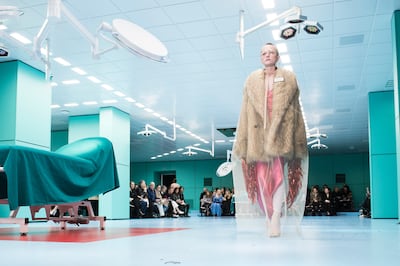
Gucci Autumn/Winter 2018 show | Source: Getty
ADVERTISEMENT
“I remember when I started with the guys from the studio, they wanted a reason. They needed to know every detail, the list of the colours, the list of the shapes they desired every single detail. They said, ‘We need to touch it and put something of us inside at the very beginning, like a tailor.’ They felt the rules, like they were in a factory. Now they’ve changed completely. They feel more liberated, with colour for example. They were scared of colour. They would ask, ‘What does this touch of yellow mean?’ I would say, ‘Nothing, it’s just me.’ And when I started to put black things together, they said, ‘Why black?’ Davide [Renne, the designer of the women’s ready-to-wear collection] was so shocked.”
I propose to Michele that he may be something of a shaman, as he once said his father was. The penetrating gaze, the hair, the beard, the jewellery, the lengthy ruminations on the spirit world: it all fits. He laughs at the idea. Still, I think Michele’s going to make an incredible old man. “I feel just the way I did when I was ten years old,” he counters. “I will be an old man, but I will take care of my inner child forever.”
That is Vincenzo's enduring influence. He worked for Alitalia, the Italian national airline, but he was also a sculptor and painter who spent every spare moment in his studio. If Michele's mother Eralda kept good time, Vincenzo rejected it. "The clock was a sign of something we didn't care about," Alessandro recalls. "In Rome, the past is incredible. We are in a contemporary world, but when you are surrounded by ancient history, it helps you understand that what you are looking at is not what you think. You are not just here. Life is made up of many layers, like a big cake. But you need someone from the very beginning to help you understand that, to help you learn how you can feel better through art and beauty. You need a teacher. My dad walked with me through the parks and the museums, spending hours and hours in front of statues. He taught me the rules, but he also showed me I could try and walk on other paths."
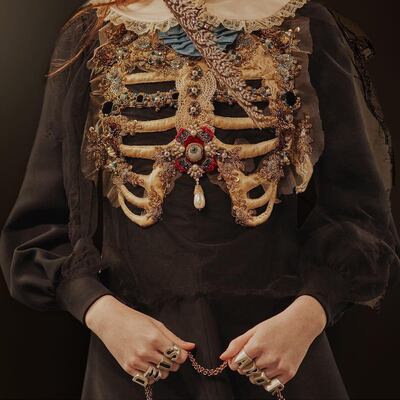
A collared gown featuring ornate decoration inspired by detail from an ossuary from the Gucci Cruise 2019 collection | Source: Instagram/Gucci
Vincenzo saw the power of creativity as a passport to another dimension, where time and death, its ultimate weapon, didn't exist. It was a lesson his son clearly took to heart. "Movies, literature, art, all these things are contro morte, against death," Michele insists. And so, he adds, is fashion.
In the midst of life, Michele is mesmerised by death. He has a simple explanation: “The closer you are to things that belong to death, the more you feel alive.” Which sounds like one more conviction that is rooted in his past. He was close to his aunt, Eralda’s twin sister, who died when he was very young. “She was 38 and she knew she was dying but she fought it with beautiful things. She was obsessed with fashion. Beauty was her medicine. And when you see something beautiful — a landscape for instance — you feel very far from the place where you will die.”
This sensibility means a perversely gorgeous morbidity is threaded through Gucci. “I love obvious signs of life, like colours,” he says, “but I’m also very attracted to the creepy things that are hidden from the daylight, where I think you find the real reasons we are alive.” The creepiness peaked in Michele’s show for Resort 2019, in the necropolis in Arles, with a suitably funereal subtext to match. It makes sense that Michele loves a cemetery. He has already paid tribute to Hollywood Forever, the movie industry’s favourite necropolis. In Arles, he said he was “trying to work like a thief with the codes of death. You need someone to explain everything in our culture, but there is just one argument where you don’t need words. In the world of the dead, you understand everything — the shapes, the cross, the symbols that talk to you from the past. When you’re in a cemetery, in front of those symbols, you understand. It’s like time stands still.”
When you see something beautiful, you feel very far from the place where you will die.
Michele’s own mortality is an issue only so far as he insists he needs to feel mortal to appreciate the sense of endless possibility that thrills him. Mortality means extremes, good and bad. He claims, for instance, that there’s little that makes him feel more alive than anxiety. “I feel like I’m living every moment, so I always feel I’m living forever. It will really be a big surprise to die.”
Which is probably why the protean mess of Michele's creative process — as he describes it, at least — feels like a pretty archetypal bulwark against temporal imprecations. And there is an emphasis on mess. "That's where I start, everything just floating around me for months — a weird shape, an unbelievable colour combination, mad embroidery, a saint, a painting, everything from Lana Turner to Lana del Ray. Each time, you need to invent a space that will help you, where you can work on the clothes, on the face, on the story. It's like a movie. You need to push yourself to find that space. And every time, I don't have enough space, enough people. When I am working, I'm definitely dying every time. And I think this is the last time because it's too much. But it's like when you're with your therapist. You know what you want to say."
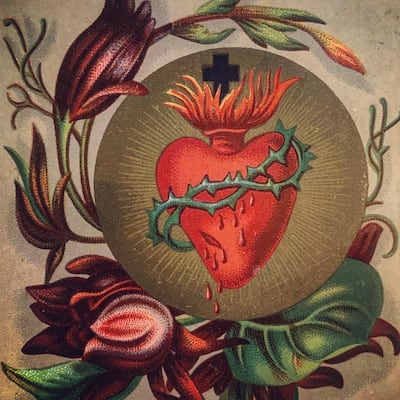
Michele is attracted to the idea of divinity and the images of Catholicism | Source: Instagram/Alessandro Michele
Michele has been in therapy for a year now. “I need it for my job. It helps me a lot because it’s just space, me and the therapist. I don’t know anything about her, I don’t feel pressure about billions of euros. That’s not me, I’m not really good with money. It’s more about the pressure I feel in this kind of…” Michele’s voice trails off. “It’s like I have two lives, my dogs and my devils. I’m always with my devils. This work is like a psychological disease because of the way I work. I always go deep inside things I hate, things I love, things that make me happy or mad, the past, the present, the faces… it’s not just a beautiful colour. It’s an obsession I go to sleep with and wake up with.”
And yet Michele insists he sleeps well, although he’s a big dreamer. “It’s another life. When I go to the therapist, I always have to choose between the night and the day. Sometimes when I got to sleep, I say to Vanni, ‘I hope it won’t be quite so heavy tonight because I’m tired.’ I always get in touch with people, sometimes with my mum, sometimes with my dad.” Appearances to the contrary, his dreams don’t really intrude on his work. “But I’m very conditioned by them. I’m always in between. When I wake up in the morning, something is still inside me for hours and hours.”
Michele lost both his parents within two years of each other 15 years ago. Inevitably, he felt the loneliness of orphanhood. Now he says, “I am my family, me alone. I think I’m more than one person. When I feel happy, it’s like all the Alessandros are in a good place together.” Since he’s been in therapy, he’s learned that there is a lot of him. He’s been coming to grips with which one does what. “You always fight with the other piece of you. When you try to be less nervous, you have to fight with the one who is nervous.” I tell him that sounds a lot like the M.Night Shyamalan shocker "Split." He quickly insists, “There isn’t an evil Alessandro.”
When you see something beautiful, you feel very far from the place where you will die.
Still, Michele prizes the notion that his work is disturbing. His beauty is twisted, often masked in some way. “I start to put together something that comes from the stomach, the idea that you are desperate in the way you want to look beautiful, that we are all desperate in the way we want to show ourselves. It’s like I’m starting to make the most unbelievable costume for the most unbelievable movie.” The Autumn/Winter show in Milan was called Cyborg. The set was a real operating theatre, “a place where you can let a piece of you die and something else be reborn.” Painfully, cathartically, like a phoenix. The same idea was on show in Arles, where the models walked through rivers of fire. Birth, death, rebirth… a mythological life cycle.
Michele says he was never obsessed with fashion history. “I was more in love with rock’n’roll, Joy Division, Siouxsie and the Banshees, people that create themselves with clothes. I was in love with the way they looked in magazines, in love with the idea that when you put something on, you become a god of rock. I’m trying to make everyone like gods. I’m not Catholic, but I’m attracted to the idea of divinity and the images of Catholicism. Things that belong on another earth.”

At the Autumn/Winter 2018 show, models appeared with eyes on their hands and with a third eye on a forehead, symbolising the heightening and emphasising of the senses | Source: Instagram/Gucci
“One year ago, I was looking at this very old book of medieval garden designs and I was thinking that we had to get inside the illustrations of these imaginary places.” Michele slips into musing mode. “People at that time didn’t want to be in reality, so they imagined gardens that didn’t exist. Now you can do that with Google. It’s why I’m completely crazy for technology. I use the iPad a lot. I want to stay in this playground that could be real but is not.”
“What’s real?” I ask. “Nothing,” Michele answers. “I want to try to stay away from reality just so I can work. Otherwise, if everything is certain and I can see it and touch it, it’s almost as though my work is done, and we’re just talking and that’s it. But that’s not enough. I prefer to spend my life in the garden that doesn’t exist.”
The most famous such place is the Garden of Eden. “The most powerful place on Earth,” Michele calls it. “And we’re trying to get back there.” I’m imagining Gucci as his stairway to paradise, and I’m happy to join him on the journey. Clearly, so are millions of other dreamers.
Related Stories:
[ Reinventing GucciOpens in new window ]
[ Is Inclusivity the New Exclusivity? Gucci Certainly Thinks SoOpens in new window ]
[ How Long Can Kering’s Blockbuster Success Continue?Opens in new window ]
From analysis of the global fashion and beauty industries to career and personal advice, BoF’s founder and CEO, Imran Amed, will be answering your questions on Sunday, February 18, 2024 during London Fashion Week.
The State of Fashion 2024 breaks down the 10 themes that will define the industry in the year ahead.
Imran Amed reviews the most important fashion stories of the year and shares his predictions on what this means for the industry in 2024.
After three days of inspiring talks, guests closed out BoF’s gathering for big thinkers with a black tie gala followed by an intimate performance from Rita Ora — guest starring Billy Porter.